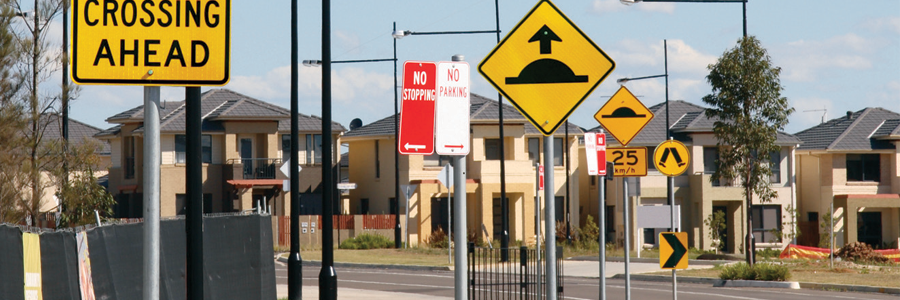How to install road signs

Successfully install road signs with these 4 important tips
Using Australian road and traffic control sign equipment from Jaybro
The range of traffic control supplies on the market covers a wide range of different products, from temporary and permanent road signs to sign posts, caps, brackets and street signs and installation tools like Loc-Sockets, wedges as well as socket pulling tools for removing and replacing old signs.
These items all serve an important purpose: they’re designed to help road users find their way and navigate traffic safely. By installing permanent road signs and traffic management equipment, contractors help make Australia’s roads safer and help road users get from point A to point B more efficiently.
Installing road and street signs
If you need to install a street sign, it’s important to have the right equipment at hand for a successful installation.
How to install signs, where to put them and specific clearances and sign materials is typically dictated by the road authority in your state. Each road authority will have its own requirements for any signs that are part of the road network. This includes wayfinding signs such as street blades, arrows and directional signs, speed signs and parking signs.
1. Always check with your local road authority, for example, the NSW RMS, VicRoads or QLD TMR for regulations regarding installing road signs. The relevant road authority will have specifications for proper installation, such as turning signs a few degrees away from level so that they are not blindingly reflective in headlights.
2. To install most types of road signs, you’ll need the sign itself, a sign post, a bracket to attach the two together, and a method for securing your post into the ground. Some sign posts are concreted directly into the ground whilst others use a socket sleeve and base plate arrangement, where the sign pole slips into a permanent socket that is embedded in the ground. These are known as V lock posts sockets, and they work by incorporating a locking ‘wedge’ into the permanent sleeve in the ground, which jams against the sign post to hold it in place.
3. Another way to install street and traffic signs is to use a Loc-Socket which is installed in a similar way. The post socket is installed into concrete, brick or pavement and sits flush with the ground. Then a wedge is driven alongside the post to secure it. The wedge is removable with a special tool which allows damaged or bent sign posts to be removed easily without having to dig out the concrete footing.
4. No matter which method you use, it’s always a wise idea to add a sign post cap to the top of the post. This will stop water ingress and discourage rust and corrosion.
Installing multiple signs on one post
Sometimes it can give a neater result to install two signs on one post, using a special bracket that holds two signs next to each other.
This installation method can often be seen in parking signs where one sign indicates a parking area and the other indicates certain time limits for motorists.
A double sign bracket method is preferred by some road authorities as it helps to avoid a proliferation of sign poles on the roadside.
Which are the best sign posts for road signs?
In the main, galvanized steel tube sign posts are used across Australia to install a wide range of standard signs. These come in 50mm NB, in a range of different heights from 2.4m to 3.9m.
In WA, square powder coated yellow RHS sign posts are used.
There are different accessories available to help you easily install your street signs onto steel sign posts. These include different types of brackets, caps for the top of the sign pole, and different types of sockets and sleeves to install them into the ground.
Large signs that are manufactured from multiple pieces of aluminium usually need to have bracing across the back for extra support. These are attached to specially made gantry posts or larger types of sign posts and can be seen on freeways, main roads and busy intersections.
Maintaining road signs: when should I replace a sign?
Although signs are specifically manufactured to last for decades, they can often be damaged earlier and require replacement.
Environmental factors such as hail, graffiti or heavy exhaust fumes, and changed conditions such as the growth of surrounding trees or a new road alignment can mean that your street signs need replacing or removing. Colours can fade over time due to UV damage, and reflective sheeting can sometimes peel due to extreme weather.
It’s a good idea for contractors, councils and road maintenance crews to have a periodic scheduled maintenance program to ensure the signs in your local area are in tip-top condition. The road sign should have the material class and the manufacture date marked on the back so you can estimate when review or maintenance may be needed.
What about temporary road signs?
Temporary road signs are also heavily used throughout the country to indicate changed road conditions and road works. These are usually made from reflective aluminium sheet with a boxed edge, or they are coupled with a swing stand to ensure they are securely mounted on the road or kerb where motorists can see them. In some states, multi-message signs are used, which are a combination of warning messages and speed discs mounted in a metal frame.
Traffic controllers need these kind of traffic management signs to make road work projects run smoothly, and ensure pedestrians and motorists are not put at risk.
Where can I buy supplies to help me install road signs?
Jaybro is a road signage supplier with branches across Australia. We deliver fast and offer great low rates with discounts for bulk orders.
If you’re a contractor looking for a regular supplier of road safety equipment, get in touch with our friendly team today to set up an account, or use our easy online store to buy traffic control supplies, road signage and road safety equipment.
 Sign In
Sign In 




